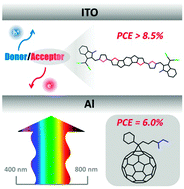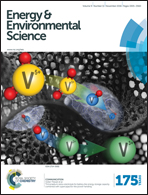Non-fullerene polymer solar cells based on a selenophene-containing fused-ring acceptor with photovoltaic performance of 8.6%†
Abstract
In this work, we present a non-fullerene electron acceptor bearing a fused five-heterocyclic ring containing selenium atoms, denoted as IDSe-T-IC, for fullerene-free polymer solar cells (PSCs). This molecule exhibits a low band gap (Eg = 1.52 eV), strong absorption in the 600–850 nm region and a high LUMO level (−3.79 eV). When a large band gap polymer J51 (Eg = 1.91 eV) was used as the donor, complementary absorption of the polymer donor and acceptor was obtained in the wavelength range of 350–850 nm. The solar cell based on J51:IDSe-T-IC gives a maximum PCE of 8.6%, with a high Voc of 0.91 V, a Jsc of 15.20 mA cm−2 and a fill factor (FF) of 62.0%. Moreover, this performance is much higher than that of J51:PC71BM based PSCs under similar device fabrication conditions (PCE = 6.0%). The trade-off features of the Jsc and Voc existing in PSCs with fullerene acceptors have been minimized in the fullerene-free PSCs based on IDSe-T-IC and J51. The results demonstrate that fine-tuning the absorption and electronic energy levels of non-fullerene acceptors, and properly selecting a polymer donor to achieve complementary absorption, is a promising way to further improve the performance of the PSCs.


 Please wait while we load your content...
Please wait while we load your content...